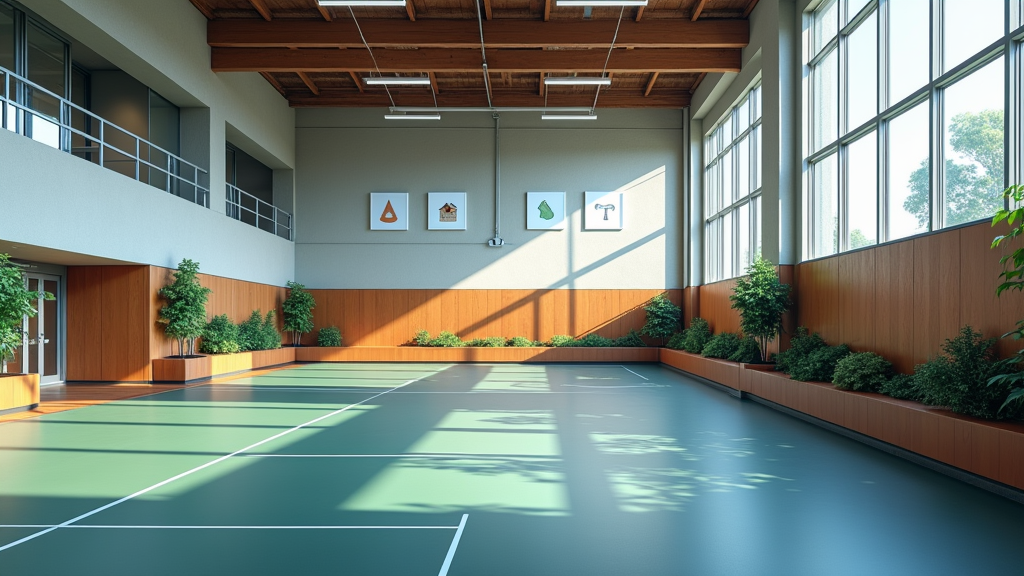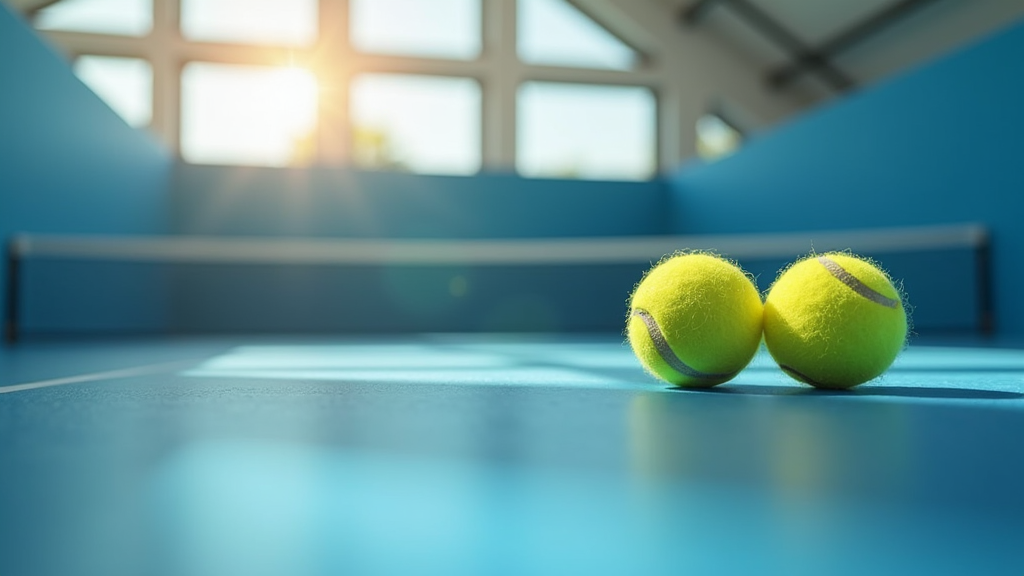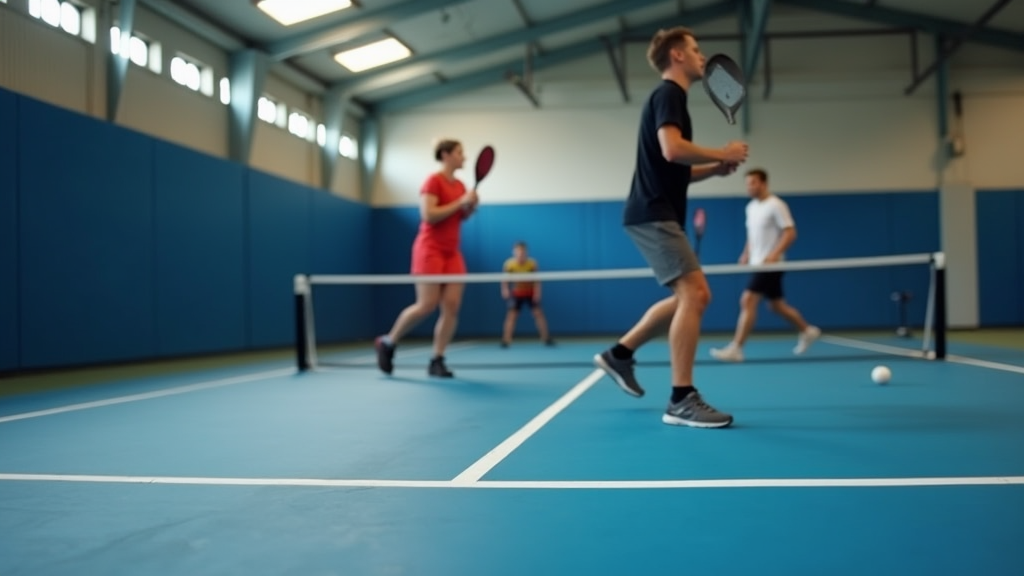Table of Contents
- Introduction
- Understanding Indoor Pickleball Facilities
- Exploring Specific Indoor Pickleball Locations
- Accessing Indoor Pickleball Facilities
- Maximizing Your Indoor Pickleball Experience
Introduction

Overview and Importance
Pickleball’s popularity has exploded in recent years, transforming it from a niche pastime to a mainstream sport. This surge in participation has created a significant demand for indoor pickleball facilities. These facilities are crucial because they provide a consistent, weather-independent environment for players to enjoy the game year-round.
The statistics speak volumes: pickleball is one of the fastest-growing sports in America, with participation rates soaring. Indoor facilities are becoming increasingly essential to accommodate this growth, offering structured play, lessons, and competitive opportunities. This matters because indoor facilities enhance accessibility, ensure consistent playing conditions, and foster a stronger sense of community among pickleball enthusiasts.
Background
Pickleball’s journey from a simple backyard game to an organized sport with a dedicated following is quite remarkable. Originating in 1965, it gradually gained traction as a recreational activity. However, the last decade has witnessed an unprecedented surge in its popularity, fueled by its accessibility and social nature.
Recent developments have seen a significant increase in dedicated indoor pickleball facilities. These aren’t just repurposed spaces; many are specifically designed with optimal court dimensions, lighting, and surfacing. Furthermore, specialized programs, including coaching sessions, leagues, and tournaments, are becoming increasingly common, catering to players of all skill levels.
What You’ll Learn
In this blog post, we’ll delve into the core concepts of indoor pickleball, providing you with a comprehensive understanding of what these facilities offer. We’ll explore the key features of indoor courts, the various types of programs available, and the different access options you can consider.
Our aim is to equip you with the practical knowledge you need to find, access, and fully enjoy indoor pickleball facilities. Whether you’re a seasoned player or new to the sport, this guide will help you make the most of the indoor pickleball experience.
Understanding Indoor Pickleball Facilities
Fundamental Concepts
Indoor pickleball is rapidly gaining popularity, and understanding the different types of facilities and their core principles is crucial for both players and facility operators. Let’s break down some key definitions. Dedicated pickleball courts are facilities designed exclusively for pickleball, often featuring multiple courts and amenities tailored to the sport. Multi-sport facilities, on the other hand, accommodate various activities, with pickleball lines often overlaid on basketball or volleyball courts. Open play refers to scheduled times when players can drop in and play without pre-arranged matches. Leagues are organized competitions with teams or individuals playing regularly over a set period. Tournaments are larger, often one-time events that draw players from different locations to compete for prizes and rankings.
Beyond these definitions, several core principles underpin successful indoor pickleball facilities. Accessibility is paramount; facilities should be conveniently located and offer various membership or drop-in options to cater to different player needs. The quality of the courts themselves is essential, impacting player experience and safety. Program variety, including lessons, clinics, and social events, can enhance engagement and attract a broader range of players. Finally, community building is vital; fostering a welcoming and inclusive environment encourages players to connect, socialize, and return regularly.
Essential Components
An indoor pickleball facility requires specific elements to ensure a safe and enjoyable playing experience. Let’s start with the required elements. A standard pickleball court measures 20 feet wide and 44 feet long, following the official guidelines. The net height is also crucial, standing 36 inches at the sidelines and 34 inches in the center. Proper lighting is non-negotiable; consistent illumination across the court surface is essential for visibility and safety. A recommended level is around 500 lux to eliminate shadows and ensure players can clearly see the ball.
Beyond the basics, several key features can significantly enhance the quality of an indoor pickleball facility. The court surface material plays a huge role in the game. Acrylic and polyurethane are common choices, each offering different levels of grip and shock absorption. Grip affects a player’s ability to move and change direction, while shock absorption reduces the impact on joints. Sound suppression is another often overlooked but very important feature. Acoustic panels or specialized materials can significantly reduce noise levels, creating a more pleasant playing environment. Finally, climate control, provided by HVAC systems, is essential for maintaining comfortable temperature and humidity levels, especially in regions with extreme weather conditions.
It’s also important to consider the variations in court types. Multi-sport courts are common, especially in community centers and schools, where pickleball lines are overlaid on existing basketball or volleyball courts. While this allows for shared use of space, it can sometimes compromise the playing experience due to less-than-ideal surface conditions or distracting line markings. Dedicated facilities, purpose-built for pickleball, offer optimal playing conditions with consistent surfaces, excellent lighting, and features designed specifically for the sport. These facilities often provide a more premium experience and cater to serious pickleball enthusiasts.
Exploring Specific Indoor Pickleball Locations

Era Pickleball: A New Style of Competitive Play
Era Pickleball is redefining the pickleball experience with its focus on competitive play and community building. It’s more than just a place to play; it’s a hub for pickleball enthusiasts of all skill levels.
- Features:Era Pickleball offers open play sessions and organized leagues, all easily managed through a user-friendly booking app. This makes it simple to find games and track your progress.
- Instruction:Whether you’re a beginner or looking to refine your skills, Era provides private one-on-one sessions and engaging group clinics led by experienced instructors.
- Facilities:Step onto one of the eight premium indoor courts, designed with optimal lighting and superior sound suppression for an immersive and distraction-free playing environment.
- Community and Atmosphere:Era Pickleball fosters a welcoming and inclusive community, promoting a family of pickleball enthusiasts who share a passion for the game.
- Events:Looking for a unique venue? Era Pickleball offers the option to host parties or corporate events, combining the fun of pickleball with a social gathering.
- Team:The passionate team at Era is dedicated to creating an inclusive environment where everyone feels welcome and supported.
- Sponsors and Partners:Era proudly displays its partners and sponsors, and is always open to new brand collaborations that align with its values.
- Membership:Joining Era Pickleball means becoming part of a larger pickleball family, with access to exclusive events, discounts, and a supportive community.
Indoor Pickleball Facilities: Venue Features
This facility is designed to be more than just a place to play pickleball; it’s a destination for entertainment, socializing, and wellness.
- Facilities:With 21 dedicated pickleball courts, you’ll always find a place to play.
- Courtside Amenities:Relax and socialize in lounge-style seating with convenient courtside service.
- Stadium Court:Experience the thrill of playing or watching matches in the stadium court, which can accommodate over 300 spectators.
- Pickleball Programming:Whether you’re a beginner or an advanced player, you’ll find classes and open play sessions tailored to all ages and skill levels.
- Leagues & Tournaments:Join a league, participate in friendly competitions, or test your skills in organized tournaments.
- Entertainment:Enjoy a diverse range of entertainment options, including Pro-Am Matches, DJ Sets, and even Glow in the Dark events.
- Food & Beverage Options:Refuel at the café, offering a selection of pastries, fresh juices, and delicious wood-fired pizza.
- Additional Facilities:Beyond pickleball, you can enjoy shuffleboard tables, golf simulators, a dart lounge, and a fitness and wellness center.
- Membership Events:Note that events at the Bosse Sports Lounge are strictly for those 21 and older.
- Hosting Options:Consider hosting private viewings or celebrating special events at the Bosse Enoteca.
- Contact Information:For inquiries, you can reach them at (617)-609-1800.
- Memorable Experiences:This venue offers diverse experiences that go beyond just pickleball, making it a destination for fun and entertainment.
Ragsdale YMCA Pickleball Court: Jamestown, North Carolina
For those in the Jamestown, North Carolina area, the Ragsdale YMCA offers a convenient and accessible option for playing pickleball.
- Location:The Ragsdale YMCA is located in Jamestown, North Carolina.
- Facilities:The YMCA features both indoor and outdoor courts, with two of each available.
- Access:
- Age Restrictions:There are no specific age restrictions, but safety guidelines are in place for younger players to ensure a safe environment.
- Equipment:Players are required to bring their own paddles and balls. However, rental or borrowing options may be available at the front desk.
- Crowdedness:The courts can be moderately busy during peak hours, especially on weekends and after work.
- Tournaments/Leagues:The Ragsdale YMCA organizes tournaments and leagues throughout the year. Check their schedule for eligibility requirements and registration details.
- Access requires a YMCA membership.
- Non-members can purchase guest passes, available in daily or weekly rates.
Accessing Indoor Pickleball Facilities
Membership Options
Many indoor pickleball facilities offer membership options designed to cater to various levels of play and commitment. These memberships typically fall into categories such as individual, family, and corporate, each with its own set of benefits and pricing.
- Individual Memberships:Ideal for solo players who want regular access to the courts.
- Family Memberships:Perfect for households where multiple family members enjoy playing pickleball, often providing cost savings compared to individual memberships for each person.
- Corporate Memberships:Geared towards businesses looking to offer recreational activities for their employees, promoting wellness and team building.
The benefits of becoming a member often extend beyond just court access. Members frequently enjoy perks such as the ability to reserve courts in advance, discounted rates on court fees and programs, and exclusive access to members-only events and tournaments. These benefits can significantly enhance the overall pickleball experience and provide a sense of community.
Pricing structures vary from facility to facility. Common options include monthly subscriptions, annual memberships, and pay-per-play alternatives. Monthly or annual memberships provide predictable costs and are beneficial for frequent players, while pay-per-play options offer flexibility for those who play less often or want to try out different facilities.
Guest Passes and Drop-In Play
For those who aren’t ready to commit to a full membership, guest passes and drop-in play offer excellent alternatives for accessing indoor pickleball facilities. These options allow non-members to experience the facility and play without a long-term commitment.
Many facilities offer daily or weekly guest passes, providing temporary access to the courts and amenities. This is a great way for visitors or occasional players to enjoy a game. The availability of guest passes can vary, so it’s always a good idea to check with the facility in advance.
Booking a guest pass or drop-in session often involves using the facility’s online reservation system, making a phone booking, or simply walking in and hoping for court availability. Online reservation systems are becoming increasingly popular, allowing players to easily view available times and book their spot. Walk-in availability is generally less predictable, especially during peak hours.
The costs associated with guest passes and drop-in play vary depending on the facility, the time of day, and the duration of play. Expect to pay a per-session fee, which might be higher during peak hours. Some facilities may also offer discounted rates for off-peak times.
Court Reservations
Securing a court at an indoor pickleball facility often requires advance planning, especially during popular times. Many facilities utilize online platforms to streamline the court reservation process.
Popular online platforms include apps like CourtReserve and PlayTime Scheduler, as well as facility-specific software. These platforms allow players to view court availability, book their preferred time slots, and manage their reservations. Some platforms also offer features such as player matching and event registration.
Booking policies vary from facility to facility. Common policies include advance booking windows (e.g., allowing reservations up to a week or two in advance), cancellation policies (specifying the timeframe for canceling a reservation without penalty), and court fees (which may vary depending on the time of day and the type of membership).
Peak hours, such as evenings and weekends, tend to be the most in-demand times for court reservations. During these times, it’s crucial to plan ahead and book your court well in advance to avoid disappointment. Flexibility in scheduling can also be helpful, as off-peak hours often have greater availability.
Maximizing Your Indoor Pickleball Experience

Etiquette and Rules
Indoor pickleball, like any sport, thrives on mutual respect and a shared understanding of the rules. Adhering to proper etiquette ensures a pleasant experience for everyone on the court.
- Court etiquette: This includes respecting other players by avoiding unnecessary noise during play, waiting until a point is over before crossing behind a court, and offering encouragement to your partner and opponents. Proper warm-up procedures are also crucial; arrive early to stretch and practice a few shots before the game begins. Sideline behavior matters too – keep conversations respectful and avoid coaching players during a match unless you are their designated coach.
- Official rules: Familiarize yourself with the official rules of pickleball as defined by the USA Pickleball Association (USAPA). Understanding these rules ensures fair play and avoids disputes. Key rules to know include serving regulations, the double-bounce rule, the non-volley zone (kitchen) rules, and scoring procedures. The USAPA website is an excellent resource for the most up-to-date rulebook.
- Safety guidelines: Prioritize safety to avoid injuries. Wearing proper athletic footwear with good ankle support is essential for quick movements and changes in direction. Stay hydrated by drinking plenty of water before, during, and after play. Warm up adequately before each session to prepare your muscles and joints. Be mindful of your surroundings and other players to prevent collisions. If you’re new to the sport, consider starting with beginner-friendly sessions to learn the fundamentals and avoid overexertion.
Improving Your Game
Whether you’re a beginner or an experienced player, there’s always room for improvement in pickleball. A combination of instruction, focused practice, and strategic thinking can elevate your game to the next level.
- Instruction: Consider seeking professional coaching to refine your technique and learn new strategies. Many clubs and facilities offer group clinics that cover fundamental skills and game situations. Private lessons provide personalized attention and allow you to focus on specific areas of your game that need improvement. Look for certified instructors who have a proven track record of helping players improve.
- Drills and practice: Dedicated practice is crucial for developing consistency and mastering essential skills. Focus on drills that target specific aspects of the game, such as dinking, volleying, serving, and third-shot drops. Dinking drills can improve your soft game and control around the non-volley zone. Volleying drills enhance your reflexes and ability to react quickly at the net. Serving practice helps you develop a consistent and effective serve. Third-shot drop drills are essential for transitioning from the baseline to the net.
- Strategy: Understanding court positioning, shot selection, and game management is vital for success in pickleball. Learn to anticipate your opponent’s moves and position yourself strategically on the court. Choose your shots wisely, considering the situation and your opponent’s weaknesses. Develop a game plan and adjust it as needed based on the flow of the match. Effective communication with your partner is also crucial for coordinating your movements and maximizing your teamwork.
Community Engagement
Indoor pickleball offers more than just physical activity; it’s also a great way to connect with others and build lasting friendships. Engaging with the pickleball community can enhance your overall experience and provide opportunities for growth and social interaction.
- Joining leagues: Participating in leagues provides a structured and competitive environment for playing pickleball. Leagues are typically organized by skill level, allowing you to compete against players of similar ability. This is a great way to test your skills, improve your game, and meet new people who share your passion for pickleball. Leagues also offer a social aspect, with opportunities to socialize with other players before and after matches.
- Participating in tournaments: Tournaments are organized events that attract players of all skill levels, from beginners to professionals. Participating in tournaments can be a challenging and rewarding experience, providing an opportunity to compete against a wider range of players and test your skills under pressure. Tournaments also offer a chance to earn rankings and recognition within the pickleball community.
- Social events: Many pickleball clubs and facilities organize social events, such as mixers, parties, and gatherings, to foster community connections. These events provide a relaxed and informal setting for players to socialize, meet new people, and build friendships. Social events can also include clinics, workshops, and other activities that promote skill development and community engagement.

